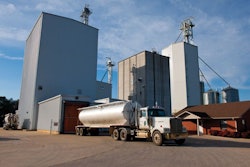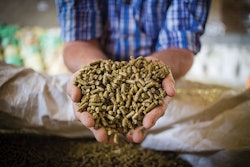
It goes largely unrecognized or ignored, but it contributes greatly to lower feed quality, especially expensive ones that contain sensitive raw materials.
The Maillard reaction is an integral part of feed manufacturing. Its adverse effects are experienced via reduced nutrient availability from thermal processing and prolonged storage in finished diets and ingredients. The Maillard reaction is a continuously going reaction in that it takes place even at room temperature at very low humidity levels. On the other hand, controlling this non-enzymatic “browning” reaction can not only prevent nutrient losses, but it may be beneficial in enhancing the flavor and palatability of processed feedstuffs.
What is the Maillard reaction?
The Maillard reaction involves binding of amino groups to the carbonyl group of reducing sugars such as glucose or lactose. This was the discovery reported by Maillard in 1912 and 1916, and hence the name of this process. Although sugar losses are greater and more intense than amino acid losses, it is the deterioration of protein quality that is of most concern to nutritionists and producers. Amino acids, and especially feed-grade ones, are quite expensive.
Browning is often confused with the intensity of the Maillard reaction. However, coloration and amino acid losses are two independent phenomena of the Maillard reaction that differ radically. During the initial stages of the Maillard reaction, products remain colorless but amino acids have already become unavailable. Therefore, color change is not a good indicator of protein quality damage, which occurs rather early.
The Maillard reaction may take place at room temperature, but its intensity increases as time, temperature, moisture (maximum at 40% to 70%), and alkalinity (linear between pH 3 and 8) increase. The initial Maillard reaction products have autocatalytic properties that further intensify the effects of heat treatment and storage.
Lysine is the most vulnerable amino acid
Under conditions of elevated temperature and humidity, any compound with a free amino group is vulnerable to the Maillard reaction, and this includes free amino acids, epsilon amino groups of protein-bound lysine, and free amino groups of vitamins such as thiamin and folacin, and even gossypol (an anti-nutritional factor).
Lysine is the most susceptible amino acid in intact proteins because it has a free amino group at the epsilon carbon unit that is readily available to react with reducing sugars. Free lysine is even more reactive because it has two free amino groups. Early Maillard reaction derivatives of lysine include N-(1-deoxy-D-fructosyl) lysine and N-(1-deoxy-D-lactulosyl) lysine.
Laboratory measurement of these compounds may be used to indicate the presence or initiation of Maillard reaction. These compounds are deaminated only by intestinal microflora and thus are not available to mammals and birds. Because destruction of lysine is often 5 to 15 times greater than that occurring with other amino acids (such as methionine, cystine, tryptophan), changes in its bioavailability indicate the occurrence and intensity of the Maillard reaction. This is why another test of the Maillard reaction process is that of reactive lysine.
How is lysine affected?
Destruction of lysine is accomplished in two ways. First, lysine is bound to sugars forming the early Maillard reaction products. Although, at this stage, lysine is still detectable in chemical assays, it is no longer bioavailable. This is why total lysine testing is not a good indicator of Maillard reaction impact on feed. Second, formation of late-Maillard reaction products such as melanoides reduce the amount of chemically analyzed lysine (Zhang and Parsons, 1994 and 1996). This is the stage where coloration intensifies, but measuring total lysine at this point might be of little use as products are already visibly “burned.”
The adverse effects of the Maillard reaction on lysine bioavailability have been extensively demonstrated in almost all feed ingredients including field peas, soybean meal, fish protein isolate, casein, egg albumin, canola meal, peanut meal, and sunflower meal. Lysine bioavailability, or rather the variability observed in this regard, is the major issue of DDGS from corn-bioethanol production as it involves excessive heating to dry the byproduct.
It has been repeatedly demonstrated that thermal over-processing of high-protein materials reduces lysine bioavailability, depending on temperature levels and the duration of heat application. In some instances, such as in cottonseed meal, digestibility may be unaffected by heat treatment although lysine bioavailability is severely reduced, which is rather confusing but true. It appears that there is an inverse relationship between temperature and time such that, as temperature declines, more time is needed for the same loss of lysine bioavailability, and vice versa.
Practical issues
Pig and calf starter products, including milk replacers, are rich in milk ingredients, and they contain high amounts of lactose and lysine. Moreover, most complex diets for young animals may contain a plethora of other equally sensitive ingredients such as blood products, concentrated soybean proteins, fish meal and wheat gluten that readily contribute to the Maillard reaction problem.
During pelleting, feed is exposed to relative high humidity and temperature levels. Usually 2% to 6% moisture is added to the mash during conditioning at temperatures that can range from 50 to 90o Celsius from several seconds to 20 or more minutes. Extremely high temperatures can also develop during pellet formation due to friction with the die walls as the conditioned mash is forced through die openings. More aggressive feed processing methods, such as expansion, extrusion, double pelleting, and prolonged mash conditioning, also increase the risk of greater nutrient destruction via the Maillard reaction.
Storage of heat-sensitive material in the form of finished diets or raw materials for prolonged periods of time can also initiate a second cycle of Maillard reaction. This is of paramount importance in feed management because the conditions of high temperature and relative humidity usually observed in most enclosed facilities for young animals are extremely favorable to the Maillard reaction.
Residual feed moisture greatly affects the extent of the Maillard reaction during storage. A 10% moisture level in milk powder stored for 10 weeks at 30o Celsius resulted in a 20% loss in lysine bioavailability. Also, exposure of a pig starter diet for one week in a hot nursery environment reduced lysine bioavailability by about 12%. Exposure of feed to adverse environmental conditions can occur not only in animal facilities, but also during storage in silos and general storage areas during the summer months.
Future research
On the positive side, Maillard reaction products are responsible for the desirable cooked flavor of feeds and foods. This may be a contributing factor associated with increased feed intake usually observed with pelleted diets. There is a paucity of meaningful information on this aspect, so further research is required to take advantage of a natural but unavoidable process in feed manufacturing. We are also lacking a simple yet standardized test to quantify the extent of Maillard reaction damage to protein quality.













